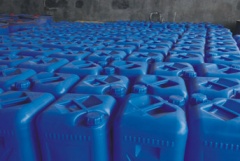Difference between revisions of "Methyl Isobutyl Ketone (MIBK)"
(Created page with "{{Infobox_Miscellaneous | image = MIBK-1.jpg | origin = | stowage factor = | humidity and moistu...") |
|||
| (One intermediate revision by the same user not shown) | |||
| Line 1: | Line 1: | ||
{{Infobox_Miscellaneous | {{Infobox_Miscellaneous | ||
| image = MIBK-1.jpg | | image = MIBK-1.jpg | ||
| − | | origin = | + | | origin = - |
| − | | stowage factor = | + | | stowage factor = - |
| − | | humidity and moisture = | + | | humidity and moisture = - |
| − | | ventilation = | + | | ventilation = - |
| − | | risk factors = | + | | risk factors = See text |
}} | }} | ||
| + | ==Description / Application== | ||
| + | Methyl isobutyl ketone; derivation, mild hydrogenation of mesityl oxide. It is slightly soluble in water, miscible with most organic solvents.<br><br> | ||
| + | Unlike the other common ketone solvents, [[acetone]] and MEK, MIBK has quite low solubility in water, making it useful for liquid-liquid extraction. It has a similar polarity to ethyl acetate, but greater stability towards aqueous acid and base. It can be used to extract gold, silver and other precious metals from cyanide solutions, such as those found at gold mines, to determine the levels of those dissolved metals. Diisobutyl ketone (DIBK), a related lipophilic ketone, is also used for this purpose. Methyl isobutyl ketone is also used as a denaturing agent for denatured alcohol. When mixed with water or isopropyl alcohol MIBK serves as a developer for PMMA electron beam lithography resist. MIBK is used as a solvent for CS in the preparation of the CS spray used currently by British police forces.<br><br> | ||
| + | Use; solvent for [[paints]], varnishes, nitrocellulose, lacquers, manufacture of methyl amyl alcohol, extraction processes including extraction of uranium from fission products, organic synthesis, denaturant for alcohol.<br><br> | ||
| + | ==Shipment / Storage / Risk factors== | ||
| + | Physical state and appearance: liquid<br> | ||
| + | Forms explosive peroxides on prolonged storage.<br> | ||
| + | Keep away from heat and sources of ignition.<br> | ||
| + | Melting point: -84,7°C<br> | ||
| + | Boiling point: 117-118°C<br> | ||
| + | Flashpoint: 14°C<br> | ||
| + | Autoignition temperature: 449°C<br><br> | ||
| + | For overseas carriage aspects of [[Chemicals]], the readers are recommended to acquire or have access to a good chemical dictionary, and a copy of the International Maritime Dangerous Goods (IMDG) Code, issued by the International Maritime Organisation. Also consult the applicable MSDS sheet.<br><br> | ||
| + | |||
| + | See also: http://www.chemicalland21.com/industrialchem/solalc/METHYL%20ISOBUTYL%20KETONE.htm<br><br> | ||
| + | |||
| + | [[Category: Products]][[Category: Oil and chemicals]] | ||
Latest revision as of 12:57, 28 October 2013
| Infobox on Methyl Isobutyl Ketone (MIBK) | |
|---|---|
| Example of Methyl Isobutyl Ketone (MIBK) |  |
| Facts | |
| Origin | - |
| Stowage factor (in m3/t) | - |
| Humidity / moisture | - |
| Ventilation | - |
| Risk factors | See text |
Methyl Isobutyl Ketone (MIBK)
Contents
Description / Application
Methyl isobutyl ketone; derivation, mild hydrogenation of mesityl oxide. It is slightly soluble in water, miscible with most organic solvents.
Unlike the other common ketone solvents, acetone and MEK, MIBK has quite low solubility in water, making it useful for liquid-liquid extraction. It has a similar polarity to ethyl acetate, but greater stability towards aqueous acid and base. It can be used to extract gold, silver and other precious metals from cyanide solutions, such as those found at gold mines, to determine the levels of those dissolved metals. Diisobutyl ketone (DIBK), a related lipophilic ketone, is also used for this purpose. Methyl isobutyl ketone is also used as a denaturing agent for denatured alcohol. When mixed with water or isopropyl alcohol MIBK serves as a developer for PMMA electron beam lithography resist. MIBK is used as a solvent for CS in the preparation of the CS spray used currently by British police forces.
Use; solvent for paints, varnishes, nitrocellulose, lacquers, manufacture of methyl amyl alcohol, extraction processes including extraction of uranium from fission products, organic synthesis, denaturant for alcohol.
Shipment / Storage / Risk factors
Physical state and appearance: liquid
Forms explosive peroxides on prolonged storage.
Keep away from heat and sources of ignition.
Melting point: -84,7°C
Boiling point: 117-118°C
Flashpoint: 14°C
Autoignition temperature: 449°C
For overseas carriage aspects of Chemicals, the readers are recommended to acquire or have access to a good chemical dictionary, and a copy of the International Maritime Dangerous Goods (IMDG) Code, issued by the International Maritime Organisation. Also consult the applicable MSDS sheet.
See also: http://www.chemicalland21.com/industrialchem/solalc/METHYL%20ISOBUTYL%20KETONE.htm











